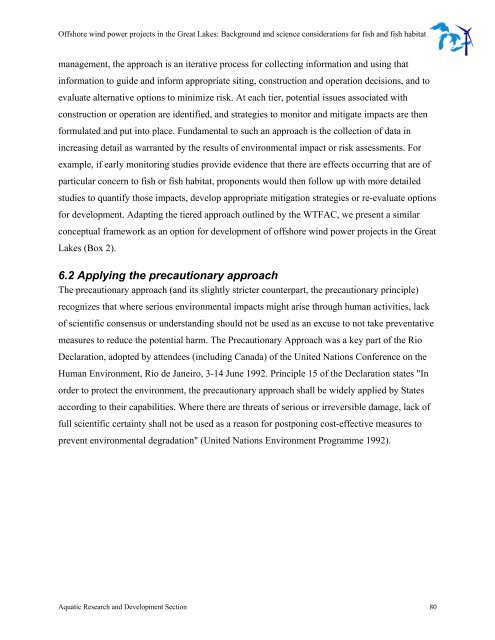Offshore Wind Power Projects in the Great Lakes - Ministry of ...
Offshore Wind Power Projects in the Great Lakes - Ministry of ...
Offshore Wind Power Projects in the Great Lakes - Ministry of ...
You also want an ePaper? Increase the reach of your titles
YUMPU automatically turns print PDFs into web optimized ePapers that Google loves.
<strong>Offshore</strong> w<strong>in</strong>d power projects <strong>in</strong> <strong>the</strong> <strong>Great</strong> <strong>Lakes</strong>: Background and science considerations for fish and fish habitat<br />
management, <strong>the</strong> approach is an iterative process for collect<strong>in</strong>g <strong>in</strong>formation and us<strong>in</strong>g that<br />
<strong>in</strong>formation to guide and <strong>in</strong>form appropriate sit<strong>in</strong>g, construction and operation decisions, and to<br />
evaluate alternative options to m<strong>in</strong>imize risk. At each tier, potential issues associated with<br />
construction or operation are identified, and strategies to monitor and mitigate impacts are <strong>the</strong>n<br />
formulated and put <strong>in</strong>to place. Fundamental to such an approach is <strong>the</strong> collection <strong>of</strong> data <strong>in</strong><br />
<strong>in</strong>creas<strong>in</strong>g detail as warranted by <strong>the</strong> results <strong>of</strong> environmental impact or risk assessments. For<br />
example, if early monitor<strong>in</strong>g studies provide evidence that <strong>the</strong>re are effects occurr<strong>in</strong>g that are <strong>of</strong><br />
particular concern to fish or fish habitat, proponents would <strong>the</strong>n follow up with more detailed<br />
studies to quantify those impacts, develop appropriate mitigation strategies or re-evaluate options<br />
for development. Adapt<strong>in</strong>g <strong>the</strong> tiered approach outl<strong>in</strong>ed by <strong>the</strong> WTFAC, we present a similar<br />
conceptual framework as an option for development <strong>of</strong> <strong>of</strong>fshore w<strong>in</strong>d power projects <strong>in</strong> <strong>the</strong> <strong>Great</strong><br />
<strong>Lakes</strong> (Box 2).<br />
6.2 Apply<strong>in</strong>g <strong>the</strong> precautionary approach<br />
The precautionary approach (and its slightly stricter counterpart, <strong>the</strong> precautionary pr<strong>in</strong>ciple)<br />
recognizes that where serious environmental impacts might arise through human activities, lack<br />
<strong>of</strong> scientific consensus or understand<strong>in</strong>g should not be used as an excuse to not take preventative<br />
measures to reduce <strong>the</strong> potential harm. The Precautionary Approach was a key part <strong>of</strong> <strong>the</strong> Rio<br />
Declaration, adopted by attendees (<strong>in</strong>clud<strong>in</strong>g Canada) <strong>of</strong> <strong>the</strong> United Nations Conference on <strong>the</strong><br />
Human Environment, Rio de Janeiro, 3-14 June 1992. Pr<strong>in</strong>ciple 15 <strong>of</strong> <strong>the</strong> Declaration states "In<br />
order to protect <strong>the</strong> environment, <strong>the</strong> precautionary approach shall be widely applied by States<br />
accord<strong>in</strong>g to <strong>the</strong>ir capabilities. Where <strong>the</strong>re are threats <strong>of</strong> serious or irreversible damage, lack <strong>of</strong><br />
full scientific certa<strong>in</strong>ty shall not be used as a reason for postpon<strong>in</strong>g cost-effective measures to<br />
prevent environmental degradation" (United Nations Environment Programme 1992).<br />
Aquatic Research and Development Section 80
















